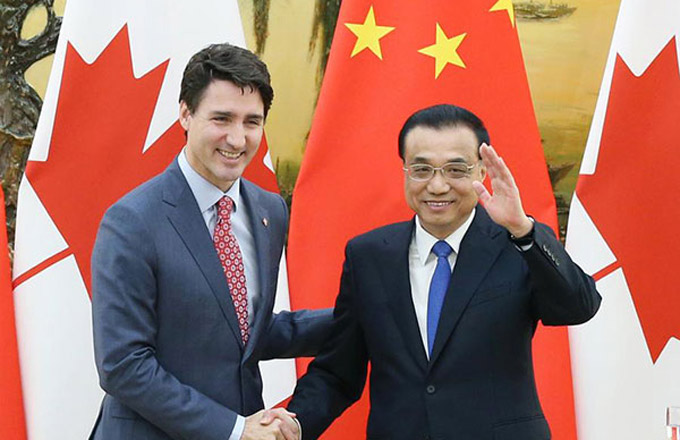Chinese brands break down barriers
As more of nation's most innovative companies gain global prominence, perceptions about their quality are changing
Huawei, Haier and Wanda are among the major players paving the way for the next wave of global Chinese brands, which are likely to rely on innovation and technological prowess to succeed.
In a move to unleash the true potential of Chinese companies, the State Council, China's Cabinet, issued a national scientific and technological innovation plan last August as a blueprint for innovation development during the 13th Five-Year Plan (2016-20).
As the world's second-largest economy undergoes a transition to put its economic development on a stronger footing, the drive for technological innovation will also enable more Chinese brands to tap global markets.
|
Customers try out laptop computers at a Lenovo outlet in Beijing in 2014. Companies like Lenovo and Huawei have shown it is possible for Chinese brands to make an impact on the world stage. Getty Images |
"Chinese tech companies are racing to take advantage of the government's favorable policies, and the most ambitious ones are aiming to establish a presence across the world," says Liang Xin, board secretary of Eternal Asia Supply Chain Management, a supply chain service provider in China.
And the gains are not limited to the tech sector. Among the most promising up-and-coming global brands is Chinese automaker Great Wall, which aims to become the world's largest manufacturer of sport utility vehicles, or SUVs, by 2020. The company has a globalization strategy in place and is working toward exporting to North America and Europe in the near future.
Smartphone makers are also looking to break new ground in global markets. Huawei and ZTE already have brand recognition in markets like Japan and are making inroads in North America and Europe. Others are following suit.
Best known within China, ride-sharing company Didi Chuxing has set up a research institute in Silicon Valley, California, to develop intelligent driving technologies.
Liang expects that in the next five to 10 years, the world will see a number of new, strong and globally-endorsed Chinese brands, and "made in China" will become an accepted and positive factor.
For the time being, Chinese brands often have to fight tooth and nail for recognition and to battle negative perceptions that link them to cheaply-manufactured products.
But those perceptions are changing, in much the same way that they changed with Japanese products in the 1970s and South Korean products in the 1990s, when companies like Samsung and Hyundai made their big international push.
"The first-tier global brands like Huawei, Haier and Lenovo have shown it is possible for Chinese companies to have a global impact, and this is creating immense aspirations among Chinese business leaders to replicate their journey," says Martin Roll, a global business and brand strategist. Roll is a CEO mentor and adviser to Fortune 100 companies.
"The primary growth driver is enhanced quality, better and unique innovation, and high global aspirations among business owners," he tells China Daily.
China grew its economy and built a reputation as a manufacturer of low-cost, low-quality goods for foreign-owned companies. Both the established and emerging global brands are now trying to shed this less-than-flattering reputation.
"The country-of-origin (COO) effect does have an influence on customers' perceptions toward products, services and brands. China has long suffered from a relatively strong negative COO effect, but it is rapidly changing for the better," Roll says.
"Chinese manufacturers are slowly but steadily embracing branding as their primary strategic driver of financial value."
Anil Gupta, a professor of global strategy at the University of Maryland in the United States, notes that the transition is "a slow process".
"There are only two Chinese brands that I can think of - Huawei and Lenovo - that have succeeded in shedding a reputation of low quality," he said.
"Others such as Haier, Xiaomi, Zoomlion and almost all other Chinese brands are still viewed as lower quality than Western, Japanese or South Korean brands."
A good example to follow might be Huawei, which has not only developed a strong brand but also good research and development capabilities in networking and consumer electronics as it learned how to compete in global markets.
The point for Huawei was to understand and not copy the technologies it needed to succeed. It also had to understand what works and what does not in different markets.
Brand strategist Roll says: "One thing is to claim to be a global company, another is to have a company that is truly global and where the culture is global - and not only an adaptation of the culture of the country of origin.
"Being truly global requires mirroring and further developing best global practices in all aspects of operations and management."
The new generation of consumers is sophisticated and picky, with a short attention span. Localization to global markets may be required for companies trying to connect with consumers outside China, and they need to balance what works with the adjustments required in order to be relevant in foreign markets.
The good news is that negative perceptions of Chinese products are declining and consumers are increasingly savvy.
More people are choosing brands based on benefits they provide rather than their fame, according to WPP, a multinational public relations company. WPP predicts that as more Chinese brands go global, consumers' receptivity toward "made in China" brands will increase, facilitating further expansion.
Chinese brands are still less globally recognized than Western icons, such as Apple, Google, Volkswagen and Louis Vuitton. However, Chinese technology brands are slowly narrowing the gap by showing they can improve lives through digital technology. Chinese innovation is at the vanguard of the global e-commerce and mobile payment space, for example.
The first BrandZ Top 30 Chinese Global Brand Builders ranking report released in January by WPP and its market research unit Millward Brown, in collaboration with Google, showed that circumstances are favorable for Chinese brands to build strength in global markets. The study showed that the notion of brand China is shifting.
Chinese brands still face an uphill struggle in global markets because international consumers "are generally less aware of, and less likely to consider purchasing, a Chinese brand than a local or globally recognized one". However, the report added, brand recognition varies significantly from country to country.
PC giant Lenovo is listed as the most powerful Chinese export brand, followed by Huawei and the e-commerce marketplace giant Alibaba.
Consumer electronics brands account for 57 percent of the ranking's total brand power - the measure of how likely consumers are to choose a particular brand - and dominate the top five with Lenovo in first place, Huawei second and Xiaomi fifth. E-commerce giant Alibaba and mobile gaming company Elex Tech round out the top five.
Combined, consumer electronics and mobile gaming lead the ranking, both in terms of the number of brands in the list (17) and combined brand power (59 percent). This shows that consumers abroad are increasingly associating brand China with innovative digital devices and services.
However, a perception of high quality for Chinese brands as a whole will take more time to establish.
"The foundation has to be high quality in the product," says the University of Maryland's Gupta. "Only then will marketing and branding efforts pay off. Merely putting more efforts into marketing and branding without real and sustained improvement in quality is a waste of money."
Analysts say that more and more Chinese companies are being created with the intention to go global rather than waiting to become a domestic giant first. Many have learned to adjust the business infrastructure as they grow.
"To leverage their global success, Chinese brands are learning to tell powerful brand stories that clearly communicate their quality and relevance," says Liang of Eternal Asia Supply Chain Management.
For China Daily



















